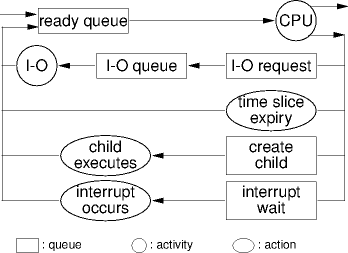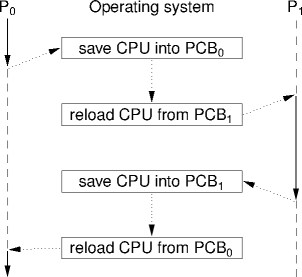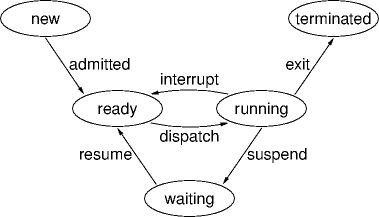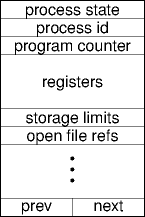Operating Systems Lecture Notes
2014 September 9 • Processes
Outline
- Process management.
- The hardware process.
- The abstract machine.
- The process abstraction.
Programs and Processes
- A program by itself is an unexecutable entity.
- Execution requires far more than just the code.
- A process is the abstraction of an executing program.
- The central abstraction implemented by an OS.
Hardware Abstraction
- To the hardware, a user looks like a process.
- What does the hardware look like to the user and process?
- An abstract machine is the OS's hardware representation

Abstract Machines
- A process (conceptually) executes in a abstract machine.
- Each process has an abstract machine, or
- processes share an abstract machine.
- It depends on what the OS implements.
- Think of an abstract machine as a custom hardware system.
- “Custom” comes from abstraction.
- For example, hide or reveal multiple CPUs.
The System-Call Interface
- What does an abstract machine look like?
- A abstract machine presents a system-call interface to processes (and users).
- A system-call interface is a set of procedure-like prototypes.
ssize_t read(int f, void * b, size_t n);
- Each prototype is a system call.
- Different system-call interfaces are different abstract machines.
The Process Abstraction
- What does a process look like?
- A process is a bag of (almost) all resources needed by a computation.
- The missing resource is the CPU.
- A process also has other points of view.
- A protection boundry.
- A (large-grained) scheduling unit.
- A smaller piece of a larger computation.
Process Managers
- The process manager is the part of the OS responsible for
implementing processes.
- Creating (and destroying) the abstraction.
- Setting the hardware to establish process characteristics.
- Address spaces, for example.
- Managing the interaction between processes and the other resources.
- Mainly scheduling, but also other coordination.
Queueing-Diagram Example

The Abstract Machine
- The abstract machine is defined by what the hardware provides and the
way the OS represents it.
- The OS can ignore features that exist or simulate features that don’t.
- The end result is the system-call interface.
- Different OSs provide different system-call interfaces.
- The same OS may provide different system-call interfaces.
The System Call
- A system call may look like a procedure, but it’s not.
- A system call transfers control from the user’s process to the
OS.
- Regular procedures stay in the the user’s process (or at least out of the OS).
- The control transfer is provided by hardware.
CPU Multiplexing

Process Implementation
- A process is a bag of resources. How’s it implemented?
- A stuct of fields, each field representing a particular resource.
- A struct instance is called a process descriptor (or process control block or task control block or …).
- There are alternate implementations.
The Process Table
- Process descriptors are usually stored in an array called the process table.
- A process ID is an index into the process table.
- There are alternate implementations here too.
- Usually a level of indirection between the table and the entries.
PCB Example
- A process (or task) control block (PCB).
- One PCB per process.
|
|
|
Computation State
- A computation’s life:

- A computation can be in one of three states.
- Unexecuted, executing, or done executing.
- A computation’s state characterizes
- What the computation is currently doing.
- What the computation could be doing.
Process State
- A computation’s state is called the process state.
- Even though the process is passive.
- The OS designer determines the
- set of possible process states and
- the way process in one state can go to another state.
- Process states and state changes are a useful way to understand an OS.
State Transitions
- A change in process state is called a process-state transition.
- Process-state transitions are caused by
- actions taken by the process or
- actions internal to the OS.
- Process actions include system calls and illegal-address (seg-fault) exceptions.
- OS internal actions include timer expiry or power-off interrupts.
Process-State Diagrams
- An OS’s process states and transitions can be modeled as a
directed, labeled graph called a process-state diagram.
- The nodes are the process states.
- The edges are the transitions.
- The edge labels are the actions causing the transition.
- The unexecuted and done executing states are usually omitted.
State-Diagram Example

Inter-Process Relations
- What’s the relation between two processes executing in a system?
- Security says “none”; each is isolated from the other, as it should be.
- That answer may be too strict.
- Groups of processes may want to cooperate.
- Other structure (hierarchies) may simplify process management.
Process Hierarchy
- One processes running another leads to a tree hierarchy.
- The parent creates the children.

- An OS can maintain this hierarchy using pointers to process descriptors.
Hierarchy Management
- Processes can share control and data along hierarchy lines.
- Control sharing occurs through the process’s lifetime.
- Data sharing is usually done only at child-create time.
- The OS can off-load to the parent some management responsibilities.
Hierarchy Problems
- Sharing along indirect or non-existent lines is hard.
- Two siblings sharing with each other.
- Establishing dynamic sharing patterns is hard.
- An on-going role-playing game.

Summary
- A process is a program in execution.
- A process is a bag of resources needed by a program to execute.
- Except for one important resource.
| This page last modified on 2014 September 10. |

